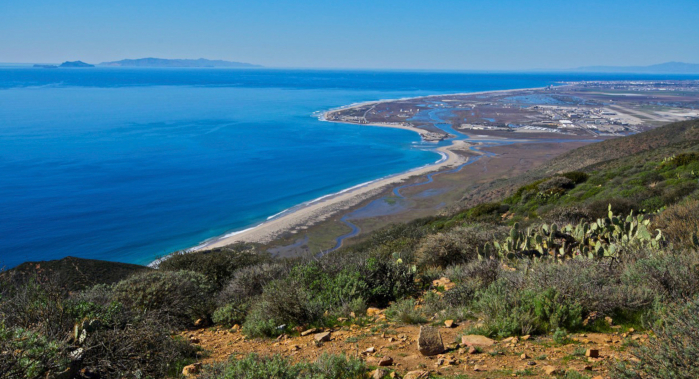Systematic, science-based conservation planning is a hallmark of the Conservancy. For biodiversity to thrive, habitats need to be protected, enhanced, or restored not just in the still wild places on the planet but also where people live and make their livelihoods.
Multi-disciplinary planning can help elucidate where the highest priority places are and what needs to happen there – and inform tradeoffs between conservation and other societal values.


A Saunders, JP Parkes, A Aguirre-Munoz, SA Morrison
Tremendous advances over recent decades in eradication of invasive species on islands raise the question whether there are now opportunities to further increase the pace and scale of that work. This…Cameron, D., K. Klausmeyer, J. Mackenzie, G. Low, L. Provencher
Climate change will impact plants and animals across the state, and conservationists are often unaware of the best way to address this threat. While much of the land in the Northern Sierra is public…Mary Gleason, Sarah Newkirk, Matt Merrifield, Jeanette Howard, Robin Cox, Megan Webb, Jennifer Koepcke, Brian Stranko, Bethany Taylor, Mike Beck, Roger Fuller, Dick VanderSchaaf, Jena Carter
While significant progress has been made over the past few decades in improving estuarine water quality, restoring wetland habitats, and incorporating estuarine habitats into managed areas, estuarine…John M. Randall, Sophie S. Parker, James Moore, Brian Cohen, Laura Crane, Bill Christian, Dick Cameron, Jason B. Mackenzie, Kirk Klausmeyer, Scott Morrison
Regional conservation planning is critical to inform land and resource use decisions. The Mojave Desert Ecoregional Assessment represents an important advance in such planning, because of how its…Susan Antenen , Dick Cameron, EJ Remson, Jason MacKenzie, Jim Gaither, Sophie Parker, Zach Principe, with Southern Sierra Partnership
This collaborative conservation assessment, characterizes the biodiversity, ecosystem services, ownerships, and land uses in the Southern Sierra and Tehachapi Mountains, and assesses threats to…Reed Tollefson, Alison Sheehey, Brian Cohen, Sophie Parker, E.J. Remson, Zach Principe, Tom Maloney, Michael White
This Conservation Action Plan identifies targets, threats, and actions to achieve conservation success in the face of climate change in the Tehachapi Mountains. The Tehachapis lie at the convergence…Mary Gleason, Scott McCreary, Melissa Miller-Henson, John Ugoretz, Evan Fox, Matt Merrifield, Will McClintock, Paulo Serpa, Kathryn Hoffman
This paper describes the planning process for California's Marine Life Protection Act (MLPA) in north central California. The process represents a case study in the design of a regional component…Howard, J, C. Revenga
Worldwide, freshwater species and habitats are, on average, more imperiled than their terrestrial or marine counterparts. Despite concerns over the health of the world’s freshwater species and…E.C. Underwood, J.H. Viers, K.R. Klausmeyer, R.L. Cox, M. R. Shaw
The mediterranean biome is one of the rarest terrestrial ecosystem types on Earth, restricted to only 2% of the world’s land surface. Encompassing portions of southern Australia, central Chile,…Erik Nelson, Guillermo Mendoza, James Regetz, Stephen Polasky, Heather Tallis, D. Richard Cameron, Kai MA Chan, Gretchen C. Daily, Joshua Goldstein, Peter M. Kareiva, Eric Lonsdorf, Robin Naidoo, Taylor H. Ricketts, M. Rebecca Shaw
Humans benefit from the goods and services provided by natural ecosystems like water filtration, carbon storage, and recreational opportunities to name a few. Assigning economic value to these…Underwood, E.C., K.R. Klausmeyer, R.L. Cox, S.M. Busby, S.A. Morrison, M.R.Shaw
Mediterranean habitats are among the rarest on Earth. Characterized by warm dry summers and cool wet winters, they are restricted to only 2% of the Earth’s land surface–portions of…Scott Morrison, Walter Boyce
Critical for biodiversity conservation is the retention of ecological connectivity in the landscape, so that wildlife—and the natural processes that sustain wildlife—can move around.…Dan Laffoley, Alan T. White, Stacey Kilarski, Mary Gleason, Scott Smith, Ghislaine Llewellyn , Jon Day , Annie Hillary, Victoria Wedell, Daphine Pee
With government, agency and organizational partners, Conservancy scientists helped publish an IUCN guidebook to inspire conservation investment in global marine protection and provide a case study…Golet G.H., M.D. Roberts , E.W. Larsen, R.A. Luster, R. Unger, G. Werner, G.G. White.
River restoration projects have the potential to influence many of the services that rivers provide to people, yet rarely is this studied in a comprehensive manner. This paper reports on a set of…Mary G. Gleason, Matt S. Merrifield, Chuck Cook, Audrey L. Davenport, Rebecca Shaw
This study is the first marine gap analysis for California. It quantifies what is protected and what is not and highlights conservation needs and opportunities. Less than 5% of marine habitats are…Mary Gleason, Matt Merrifield, Chuck Cook, Miguel Hall
The Conservancy's science and planning staff in California prepared this assessment of the most important areas for conservation of marine biodiversity in the Northern California…